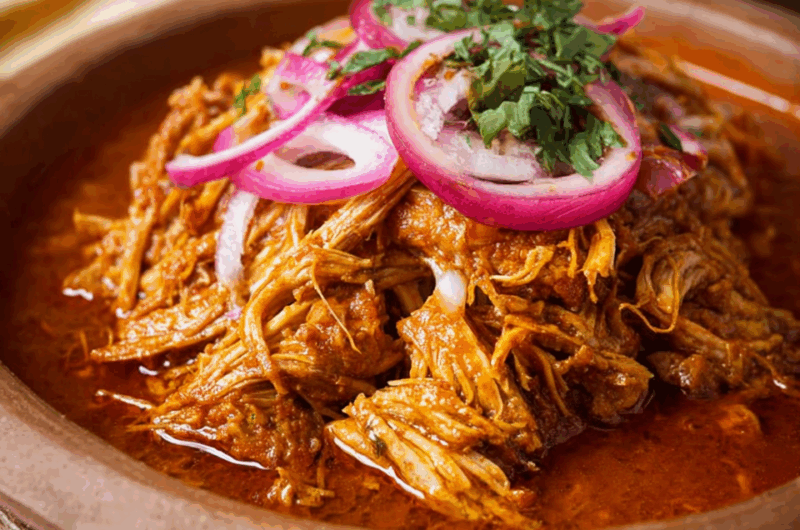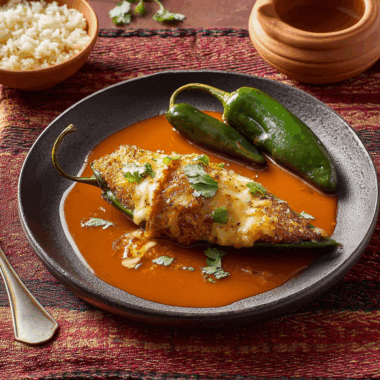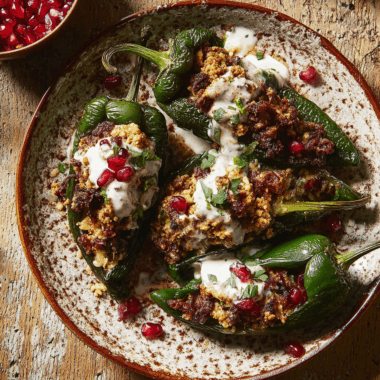Cochinita Pibil is one of the crown jewels of Yucatán cuisine, blending the rich earthy flavor of annatto seeds with the brightness of citrus and the warmth of slow roasting. Traditionally cooked underground in a pit (píib), this dish has traveled the world, winning hearts for its tender texture and vibrant taste.
What makes this dish extraordinary is the balance of flavors: the smokiness of achiote paste, the tang of orange and lime juice, and the savory depth of slow-cooked pork. Served with tortillas and pickled red onions, it becomes more than a meal – it’s a culinary journey through Mexico’s heritage. Whether for a festive dinner or a casual taco night, Cochinita Pibil always makes a lasting impression.
Full Recipe:
-
3 pounds pork shoulder (cut into large chunks)
-
1/2 cup achiote (annatto) paste
-
1/2 cup fresh orange juice
-
1/4 cup fresh lime juice
-
1/4 cup white vinegar
-
4 cloves garlic, minced
-
1 tablespoon ground cumin
-
1 tablespoon dried oregano
-
1 tablespoon smoked paprika
-
2 teaspoons salt
-
1 teaspoon ground black pepper
-
2 bay leaves
-
1 large red onion, thinly sliced
-
2 banana leaves (optional, for authentic flavor) or foil
-
Warm corn tortillas, for serving
-
Pickled red onions, for garnish
Directions:
-
In a large bowl, combine achiote paste, orange juice, lime juice, vinegar, garlic, cumin, oregano, paprika, salt, and black pepper. Mix until smooth.
-
Place pork chunks in the marinade and coat evenly. Cover and refrigerate for at least 4 hours, preferably overnight.
-
Preheat oven to 325°F (165°C).
-
Line a Dutch oven or roasting pan with banana leaves (or foil). Place marinated pork and sliced red onion inside. Add bay leaves. Wrap tightly with banana leaves and cover with lid or foil.
-
Roast in the oven for 3 1/2 to 4 hours, or until the pork is fall-apart tender.
-
Shred the pork with two forks and mix with its juices.
-
Serve hot with warm corn tortillas and pickled onions.
Prep Time: 20 minutes | Cooking Time: 4 hours | Total Time: 4 hours 20 minutes
Kcal: 385 kcal | Servings: 8 servings
The Story Behind Cochinita Pibil
Cochinita Pibil is more than just a dish; it is a culinary treasure from the Yucatán Peninsula of Mexico, steeped in centuries of history and tradition. The name itself reveals its roots: “cochinita” refers to “small pig,” while “pibil” comes from the Mayan word píib, meaning “buried.” Traditionally, this dish was prepared by marinating pork with annatto paste and citrus juices, then wrapping it in banana leaves and cooking it underground in a stone-lined pit with hot coals. This slow, natural method gave the meat its signature smoky aroma, tender texture, and deep, earthy flavors.
The origins of Cochinita Pibil can be traced back to the pre-Hispanic Mayan civilization, where annatto seeds (achiote) were prized not only as a seasoning but also as a natural dye. After the arrival of the Spanish, ingredients like pork, citrus fruits, and vinegar were incorporated into the traditional preparation, transforming it into the dish we recognize today. Cochinita Pibil is now considered a flagship of Yucatecan cuisine, celebrated both locally and internationally.
Why Cochinita Pibil Stands Out
Among Mexico’s vast and diverse culinary landscape, Cochinita Pibil is unique for its combination of flavors. Achiote paste, which is the heart of the marinade, imparts a vibrant red-orange color and a subtle earthy bitterness. This is balanced by the bright acidity of orange and lime juice, which tenderizes the meat and adds a refreshing tang. Slow cooking enhances these flavors, allowing them to penetrate deeply into the pork until every bite is infused with complexity.
Unlike other Mexican pork dishes that focus on spiciness, Cochinita Pibil emphasizes balance. The heat is mild, the citrus notes uplifting, and the annatto rich yet delicate. This harmony of flavors makes the dish approachable even for those unfamiliar with traditional Mexican food, while still staying true to its cultural heritage.
Cultural Importance in Yucatán
In Yucatán, Cochinita Pibil is not just food—it is part of family gatherings, community events, and religious celebrations. It is especially tied to the Hanal Pixán festival, the Mayan equivalent of the Day of the Dead, when families prepare Cochinita Pibil to honor and remember their ancestors. The dish’s deep connection to Mayan traditions is evident in its preparation, symbolism, and continued presence in modern-day rituals.
Street vendors, local markets, and family-run restaurants across Mérida and other Yucatecan cities frequently serve Cochinita Pibil. It has become a weekend specialty, often enjoyed with warm tortillas and pickled red onions. Despite its traditional roots, it has also found its way into upscale restaurants and modern culinary reinterpretations, showing its timeless appeal.
Cooking Techniques: Traditional vs. Modern
While the original preparation involves slow roasting in underground pits, this method is not practical for most home cooks. Instead, modern kitchens adapt the process using ovens, stovetops, or even slow cookers. The key is to maintain low, steady heat for several hours, allowing the pork to break down into succulent, pull-apart pieces. Wrapping the pork in banana leaves remains an essential element, as it locks in moisture and infuses the meat with subtle herbal undertones. When banana leaves are unavailable, foil is often used as a substitute, though purists argue that nothing compares to the authentic flavor imparted by the leaves.
This blend of tradition and adaptation reflects how Cochinita Pibil has traveled from ancient Mayan pits to modern dining tables around the world, without losing its identity.
Serving Suggestions and Accompaniments
Cochinita Pibil is most commonly served with freshly made corn tortillas, turning the tender pork into irresistible tacos. The meat’s richness pairs perfectly with the tartness of pickled red onions, a classic garnish that adds both flavor and color contrast. Some enjoy it with habanero salsa for an extra kick, while others prefer a milder version that highlights the natural citrus and achiote flavors.
Beyond tacos, Cochinita Pibil can also be served as tortas (Mexican sandwiches), tostadas, or even as a main entrée alongside rice and black beans. Its versatility makes it suitable for casual meals, festive gatherings, or elegant presentations at dinner parties.
Variations of Cochinita Pibil
Though pork is traditional, there are several variations of Cochinita Pibil to accommodate different tastes and dietary needs. Chicken is a popular substitute, marinated and cooked in the same way to achieve a lighter version of the dish. Some chefs experiment with beef or lamb, though these are less common. Vegetarian adaptations replace the meat with jackfruit or mushrooms, which absorb the marinade beautifully and mimic the texture of pulled pork.
Another notable variation is the use of different marinades. Some cooks enhance the achiote paste with additional spices such as cloves, cinnamon, or allspice, creating a more aromatic profile. Others experiment with the cooking method—using smokers, pressure cookers, or sous-vide techniques to replicate the tenderness achieved in traditional pits. These variations demonstrate the dish’s adaptability while still honoring its Yucatecan origins.
Nutritional Perspective
Cochinita Pibil is not only delicious but also relatively balanced when enjoyed in moderation. Pork shoulder provides a good source of protein and essential vitamins, while the marinade uses natural citrus juices that add vitamin C and help tenderize the meat without excessive oil or fat. Serving it with fresh vegetables, beans, or whole corn tortillas can create a well-rounded meal. As with most comfort foods, portion control and thoughtful pairings allow you to enjoy the dish while maintaining a healthy lifestyle.
Global Popularity and Influence
What started as a regional specialty has grown into a globally recognized dish, often featured in international food festivals and culinary showcases. Chefs around the world celebrate Cochinita Pibil for its rich history and depth of flavor, incorporating it into fusion dishes or modern presentations. In the United States, it is increasingly popular in Mexican restaurants, taco trucks, and even gourmet dining establishments. Its rise in popularity highlights how traditional dishes can transcend borders and become symbols of cultural pride and culinary artistry.
Tips for Making the Perfect Cochinita Pibil
Even though we are not listing step-by-step instructions, a few tips can help ensure a great outcome when preparing Cochinita Pibil at home. First, marination time is crucial—allowing the pork to sit in the achiote and citrus mixture overnight ensures that every bite is deeply flavored. Second, slow and steady cooking is non-negotiable; rushing the process can result in tough meat rather than the signature tenderness. Lastly, don’t skip the garnishes. Pickled onions and a squeeze of lime elevate the dish, balancing the richness of the pork and making the flavors pop.
Conclusion
Cochinita Pibil is more than a recipe—it is a living piece of history, blending Mayan traditions with Spanish influences to create a dish that is both comforting and sophisticated. From its roots in underground pits to its place on international menus, it represents the resilience, creativity, and passion of Mexican cuisine. Its distinctive flavor profile, versatility, and cultural significance make it a timeless favorite, whether you are enjoying it at a family gathering in Yucatán or cooking it in your own kitchen thousands of miles away.
Ultimately, Cochinita Pibil reminds us that food is not only about sustenance but also about storytelling, connection, and heritage. By savoring it, you are participating in a centuries-old tradition that continues to bring people together around the table.








